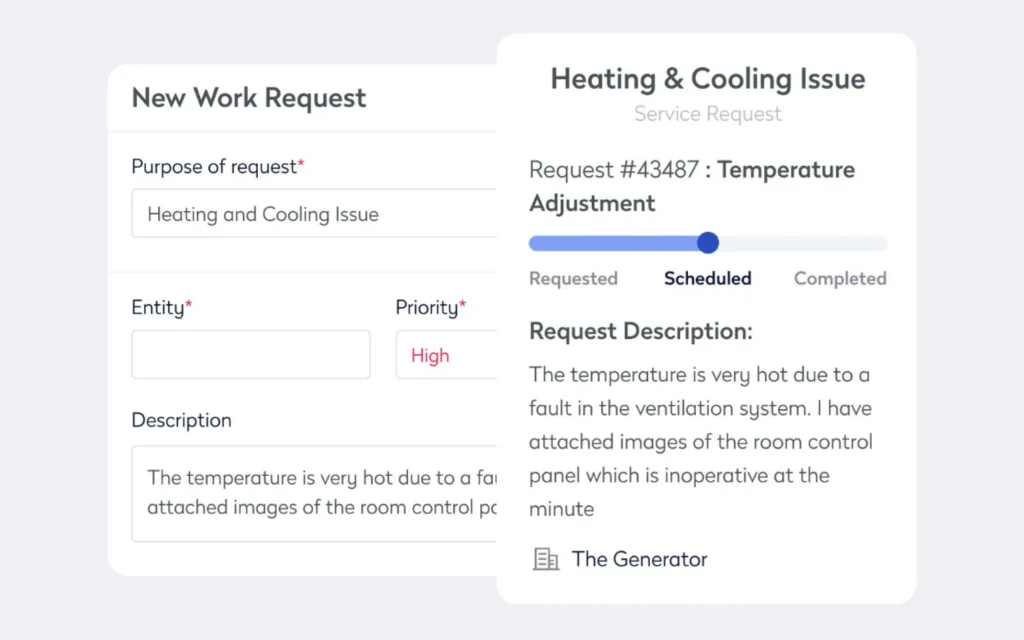
In a modern workplace, employees need to share information within their teams and across departments, from meeting schedules to project deadlines. Productivity starts when employees have reliable systems to help them connect and collaborate. But just as important are internal service requests, a system that connects employees to the facility management team, so organizations can deliver support for maintenance, repairs, information technology (IT), cleaning, and the many other services required for employee comfort and productivity.
With request management software as part of a unified asset and workplace solution, organizations can automatically route requests to the right place, boosting the employee experience while cutting overall facility and maintenance costs.
What is request management software?
Office service request software helps streamline the process of managing and responding to service requests within an organization. Requests can range from technical support and maintenance issues to administrative assistance. From a centralized platform, employees can submit requests, track progress, and receive updates. From there, facility managers can leverage the software to organize and prioritize service requests, ensuring they are assigning and addressing them effectively and efficiently.

Overall, office service request software helps reduce downtime, improve communication between departments, and enhance employee satisfaction by ensuring that workplace and facility managers can address their needs and issues promptly.
What are the must-have features for service requests?
Features include ticketing, where the software automatically logs requests as tickets, assignment, when requests are sent to the appropriate department or personnel, and tracking, which allows requesters as well as facility managers to monitor the status of each request until resolution.
Modern office service request software comes with reporting capabilities, allowing facility and maintenance managers to analyze trends, measure response times, and assess the overall efficiency of the services provided. With data-back insights, they can identify common issues, allocate resources more effectively, and improve service delivery over time.
Service submissions
Employees can easily access the platform to submit service requests to the relevant facilities or service personnel based on their category, location, and priority. Because everything is in one convenient location, they’re not wasting time tracking down the right emails or phone numbers.
Ticket tracking
The right information gets to the right people – directly. Facility managers can route requests to the appropriate personnel, prioritize them based on urgency, and track progress along every step of the ticket’s life, from submission to completion.
Third-party vendors
Without having to jump between systems, which is most often when data gets corrupted or completely lost, facility professionals can create and manage work orders for vendors and track expenses related to vendor services, bringing in the right people without breaking the budget.
Task assignment
Because they can see current workloads across teams, facility and maintenance managers can assign work orders to specific maintenance technicians or teams based on their skills, availability, and existing assignments.
Maintenance analytics
Backed with historical data from service requests and asset records, facility leaders and maintenance department can identify patterns of issues, empowering them to make better decisions on everything from asset procurement to preventive maintenance schedules, hiring needs to MRO inventory levels.

Mobile app
Moving processes to where people already are — on their phones — makes it easier to track the status of service requests and allow employees to create tickets on the go, as soon as they see an issue.
What are the benefits of service request software?
A digital service request system delivers a range of benefits.
- Streamlined processes: Service request software empowers facility managers to automate the submission, tracking, and management of requests, streamlining workflows significantly. By eliminating the need for manual entry, organizations minimize human error and increase the speed at which they can deliver services
- Improved response times: With automated systems, workplace leaders ensure that notifications and reminders arrive instantly at the right teams. Request stop slipping through the cracks, so employees feel more valued as the company is meeting their needs promptly
- Enhanced communication: With status updates, comments, and notifications, employees can check the status of their requests at any time and receive notifications when the status changes. Clear, ongoing communication loops reduce the need for back-and-forth emails and calls, which often lead to misunderstandings and delays.
- Increased transparency: Service request software provides a clear, accessible view of the entire life cycle of every request, and transparency helps manage expectations as employees can see exactly where their requests are in the process. For facility and maintenance manager, it offers an overview of the team’s workload and performance, highlighting areas that may require additional resources or process adjustments.
- Data-driven decisions: With comprehensive analytics and reporting capabilities, service request software can provide valuable insights into operational aspects such as the volume of requests, response times, and common issues. Accurate data is crucial for identifying trends, anticipating future needs, and making informed decisions about where to allocate resources or how to improve services.
- Accountability: By documenting every action taken from the moment a request is submitted until it is resolved, facility managers can enforce accountability. They can see who was responsible for each part of the process, which helps in evaluating performance and addressing any issues in the workflow. Accountability is key to maintaining high standards of service across the organization.
- Reduced downtime: Efficient handling of service requests, especially those related to critical infrastructure like IT and facilities, means problems are resolved faster, which in turn reduces downtime. Minimizing downtime is essential for maintaining productivity, as prolonged issues can disrupt the daily operations of the office and lead to significant losses.
Key benefits of service request software: Employee satisfaction
Quick and transparent handling of service requests significantly enhances employee satisfaction. When employees see that their needs are taken seriously and addressed efficiently, it boosts their morale and confidence in the management.
In fact, employee satisfaction plays a pivotal role in boosting productivity within a workplace. When employees are content and engaged, they bring a higher level of commitment and enthusiasm to their daily tasks, and the increased motivation not only enhances individual performance but also elevates the overall productivity of the company.

Satisfied employees are more likely to come to work and remain with the company, reducing both absenteeism and turnover rates. By fostering a satisfying work environment, companies can retain their valuable talent and maintain a stable, experienced workforce.
Key benefits of service request software: Scalability
Especially important for larger organizations is the ability to scale. As a company grows, the volume and complexity of service requests are likely to increase. Service request software scales with these needs. Whether it’s adding more users, handling a greater variety of requests, or integrating with other systems, the software can adapt to accommodate growth, ensuring that the quality of service does not diminish as the organization expands.
Scalable service request software typically operates on a flexible architecture. This means it can handle an increase in users, work volume, and transactional demands without the need for a complete overhaul of the system. For example, it might allow for the easy addition of new users or integration with other systems as the company expands, avoiding costly bottlenecks and system failures that could otherwise occur with non-scalable solutions.
Scalability also ensures that the software continues to run efficiently as more tasks, processes, or features are added. This is essential not only for maintaining current levels of service as the company grows but also for ensuring that the software can evolve with the company, accommodating new business needs and technologies.
By automating the request and response processes, organizations can ensure faster resolution times, reduce manual errors, and maintain a clear record of communications and transactions, not only streamlining internal operations but also fostering a positive work environment where employees feel valued and supported.








